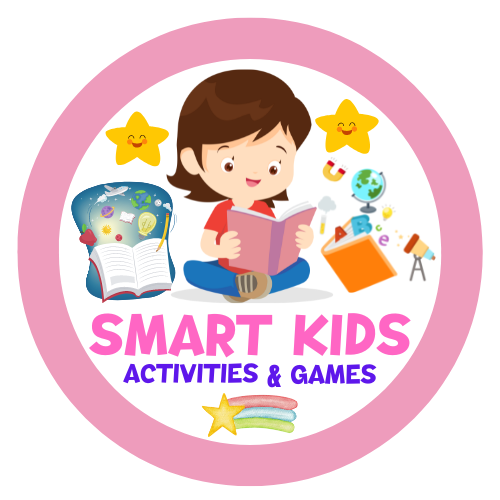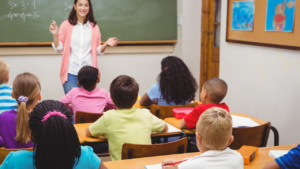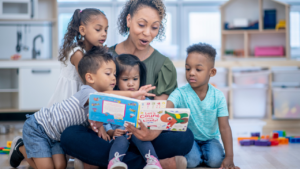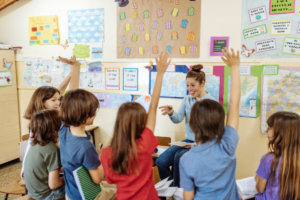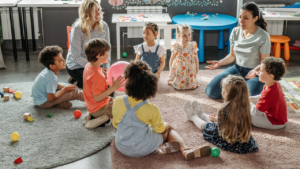Key Takeaways:
- Break down complex concepts into smaller, more digestible lessons
- Leverage technology to create interactive and innovative learning experiences
- Foster positive teacher-student relationships to create an engaging and student-centered learning environment
- Engage parents as partners to enhance student success in the classroom
- Continuously update subject knowledge to provide the best learning experiences for students
Break Down Concepts into Smaller Lessons
Studies show that students struggle to pay attention and retain information when presented with lengthy lectures or lessons. To enhance learning in the classroom, it is important for teachers to break down complex concepts into smaller, more digestible lessons. This allows students to focus on the granular details first and gradually build their understanding towards larger concepts. One effective method for breaking down concepts is the ADEPT method, which involves using analogy, diagrams, examples, plain English, and technical definitions to help students grasp the material.Leverage Technology in the Classroom
Technology has revolutionized the field of education, providing innovative learning strategies and interactive learning opportunities for students. By incorporating educational apps, games, and tools into the classroom, teachers can cultivate an engaging and effective learning experience for their students. The U.S. Department of Health & Human Services recognizes the immense potential of technology in education. It stresses the importance of utilizing technology to connect educators with valuable resources, expertise, and learning experiences that empower them to provide effective teaching for all learners. Through technological advancements, teachers can tap into a vast array of educational materials and employ interactive learning strategies that cater to diverse learning styles. “Technology in the classroom offers endless possibilities for engaging and empowering students in their education.”With technology, students can actively participate in their learning journey, fostering a sense of ownership and autonomy. Interactive learning strategies, such as gamification and virtual simulations, promote active engagement and critical thinking, allowing students to apply theoretical knowledge in practical scenarios. By exploring educational apps and tools, students can actively participate in the learning process, turning passive consumption into active creation.
Implementing Universal Design for Learning (UDL) Principles
One of the key advantages of technology in the classroom is its ability to accommodate diverse learning styles through the implementation of Universal Design for Learning (UDL) principles. UDL emphasizes the importance of providing multiple means of representation, expression, and engagement to cater to the varying needs and preferences of students. Technological tools, such as multimedia presentations, online collaborative platforms, and adaptive learning software, enable students to access information in different formats, express their understanding through various mediums, and engage with the content in ways that align with their learning preferences.Engaging with Innovative Learning Platforms
Several innovative learning platforms have emerged in recent years, offering interactive and immersive experiences for students. These platforms utilize cutting-edge technology, such as augmented reality (AR) and virtual reality (VR), to create captivating learning environments. They can transport students to historical events, simulate scientific experiments, and provide hands-on experiences that enhance understanding and retention.| Innovative Learning Platform | Description |
|---|---|
| Classcraft | Uses gamification to transform learning into an adventure, fostering engagement and collaboration among students. |
| Curiscope’s Virtuali-Tee | Combines wearable technology with AR to allow students to explore the human body in an interactive and immersive manner. |
| Google Expeditions | Enables teachers to take students on virtual field trips worldwide, exposing them to new cultures and environments without leaving the classroom. |
Foster Positive Teacher-Student Relationships
Positive teacher-student relationships play a crucial role in enhancing student-centered learning strategies and creating an engaging classroom environment. According to the American Psychological Association (APA), fostering a positive and supportive environment is essential for improving academic and social performance. Here are some effective strategies recommended by the APA to foster positive teacher-student relationships:- Set Clear Expectations: Clearly communicate your expectations for behavior, participation, and academic performance to create a structured and supportive learning environment.
- Get to Know Each Student: Take the time to understand each student individually, their interests, strengths, and challenges. Building a personal connection with students can make them feel valued and supported.
- Spend One-on-One Time: Allocate dedicated one-on-one time with students to address their specific needs, provide guidance, and offer personalized support.
- Foster a Positive Social Climate: Create a classroom atmosphere that promotes respect, inclusivity, and cooperation among students. Encourage collaboration and ensure everyone feels safe and comfortable.
- Provide Meaningful Feedback: Offer constructive feedback that is specific, timely, and focused on growth. Recognize students’ achievements and encourage them to take ownership of their learning.
| Benefits of Positive Teacher-Student Relationships | How to Foster Positive Relationships |
|---|---|
| Improved academic performance | Set clear expectations |
| Enhanced social development | Get to know each student |
| Increased student motivation | Spend one-on-one time |
| Reduced behavioral issues | Foster a positive social climate |
| Greater student engagement | Provide meaningful feedback |
Engage Parents as Partners
Parents play a vital role in supporting their children’s education. By involving parents in the learning process, teachers can enhance student success in the classroom. Building positive relationships with parents from the beginning of the school year and utilizing technology for effective communication can help strengthen the home-school connection. Involving parents in classroom activities, such as volunteering for special occasions or field trips, can also contribute to a rich and engaging learning environment.Benefits of Parent Involvement:
- Enhanced student motivation and engagement
- Improved academic performance
- Increased student attendance and participation
- Positive impact on behavior and discipline
- Support for students with diverse needs
“Research consistently shows that when parents are involved in their child’s education, the child is more likely to succeed academically.” – National Education Association (NEA)
Strategies for Engaging Parents:
- Regular communication channels, such as parent-teacher conferences, newsletters, and email updates
- Utilizing technology platforms, such as online portals and educational apps, to share student progress and assignments
- Involving parents in decision-making processes, such as classroom policies or curriculum planning
- Hosting parent workshops or seminars on topics related to education and child development
- Encouraging parent participation in school events and activities
| Benefits of Engaging Parents | Strategies for Parent Engagement |
|---|---|
| Enhanced student motivation and engagement | Regular communication channels |
| Improved academic performance | Utilizing technology platforms |
| Increased student attendance and participation | Involving parents in decision-making processes |
| Positive impact on behavior and discipline | Hosting parent workshops or seminars |
| Support for students with diverse needs | Encouraging parent participation in school events |
Continuously Update Subject Knowledge
As educators, it is essential to continuously update subject knowledge to keep lessons engaging and relevant. By staying informed about the latest developments in our fields, we can provide the best learning experiences for our students. Here are some effective strategies to stay up-to-date:1. Enroll in continuing education courses
Continuing education courses offer opportunities to expand our knowledge and learn new teaching techniques. By participating in these courses, we can gain valuable insights, discover innovative approaches, and stay current with the latest research and practices in our subject areas.2. Join professional organizations
Professional organizations provide a platform for networking, collaboration, and professional growth. By becoming a member of relevant associations, we gain access to resources, conferences, and workshops that can enhance our understanding and expertise in our respective disciplines. These organizations often provide valuable publications and forums for knowledge sharing.3. Refresh lesson plans
Regularly reviewing and updating our lesson plans helps ensure that our teaching materials align with current educational standards and incorporate the latest pedagogical approaches. By integrating new resources, technologies, and strategies into our lessons, we can engage students and maximize their learning outcomes.“Education is the kindling of a flame, not the filling of a vessel.” – SocratesBy prioritizing ongoing professional development and continuously updating our subject knowledge, we create a dynamic and enriching classroom environment that fosters effective learning. Let’s stay curious, embrace lifelong learning, and ensure that our students receive the best classroom learning strategies.
| Benefits of Continuous Subject Knowledge Updating | Strategies for Keeping Up-to-Date |
|---|---|
|
|
Seek Feedback for Continuous Improvement
Feedback is a valuable tool for continuously improving teaching skills and enhancing classroom learning strategies. By seeking feedback from various sources like school leadership, peers, and students, educators can gain valuable insights and suggestions for professional growth. It allows them to identify areas for improvement and make changes that positively impact their teaching methods. Formal assessments, such as teacher evaluations and student-led teaching assessments, can play a crucial role in this process. These assessments not only provide valuable feedback but also offer opportunities for educators to reflect on their teaching practices and make necessary adjustments. By embracing feedback, teachers can enhance their classroom learning strategies and create a more effective and engaging learning environment for their students.Benefits of Seeking Feedback:
- Personal Growth: Feedback helps educators identify their strengths and areas for improvement, leading to personal and professional growth.
- Student-Centered Approach: By incorporating feedback, teachers can tailor their lessons to meet the specific needs of their students, resulting in a more student-centered learning experience.
- Continuous Improvement: Regular feedback allows educators to continually refine their teaching strategies and stay updated with the best classroom learning practices.
“Seeking feedback from students and colleagues is vital for effective classroom learning strategies. It provides insights that help me enhance my teaching methods and create a more engaging and meaningful learning environment for my students.” – Jane Lewis, 6th Grade Teacher
Teacher Evaluation Feedback: A Valuable Resource
Teacher evaluations conducted by school leadership can provide valuable feedback on instructional techniques, classroom management, and overall effectiveness as an educator. These evaluations often include specific criteria and rubrics that help measure performance and guide professional development. By actively engaging in the evaluation process and using the feedback received, educators can identify areas where they excel and areas that need improvement. Collaborating with school leaders to develop personalized action plans can lead to significant growth and improvement in classroom learning strategies.Student-Led Teaching Assessments: A Powerful Tool
Engaging students in the feedback process empowers them to take ownership of their education and provides valuable insights into their learning experiences. Student-led teaching assessments, such as surveys or student-led conferences, offer a unique perspective on the effectiveness of classroom learning strategies. Through these assessments, educators can gather feedback on various aspects of their teaching, including lesson delivery, clarity of instructions, and classroom engagement. This feedback from students enables educators to understand their students’ perspectives and make adjustments to better meet their learning needs.| Benefits of Seeking Feedback: | Ways to Collect Feedback: |
|---|---|
|
|
Networking for Professional Growth
Networking events provide valuable opportunities for educators to expand their professional network, share ideas, and gain insights from peers outside of the classroom. By attending conferences and exclusive events tailored for teachers, professionals in the education field can foster connections that lead to career growth, mentorship, and the exchange of innovative classroom strategies. These events create a platform for like-minded individuals to come together, learn from each other’s experiences, and stay updated on the latest trends in education. They offer a unique opportunity to connect with fellow educators who share a passion for effective classroom learning strategies, ultimately enhancing the educational experience for students. During networking events, teachers can participate in panel discussions, workshops, and presentations held by industry experts. These sessions offer valuable insights and practical tips that can be implemented in the classroom to create engaging and innovative learning experiences. By attending networking events, educators can:- Expand their professional network
- Gain insights from peers
- Potentially find mentors
- Stay updated on latest trends in education
- Discover new resources and tools
Benefits of Networking for Professional Growth
“Networking events provide a supportive community of professionals who are dedicated to improving education. By connecting with like-minded individuals, educators can gain fresh perspectives, learn new approaches, and find inspiration to enhance their teaching strategies.”
Supporting Struggling Learners
Some students may face challenges in traditional learning patterns, necessitating additional support from educators. By identifying the root cause of their struggles, setting realistic goals, breaking tasks into manageable pieces, and utilizing diverse learning strategies, teachers can provide meaningful assistance to struggling learners. Incorporating technology, engaging in fun learning activities, and utilizing positive reinforcement techniques can create an environment that fosters effective and engaging learning experiences for these students.Identifying the Cause of Struggles
Understanding the specific difficulties faced by struggling learners is crucial to implementing effective support strategies. It is essential for educators to assess their students’ strengths and weaknesses, identify any learning disabilities or challenges, and tailor their instruction accordingly. By using diagnostic tools, conducting assessments, and working closely with specialists when necessary, teachers can gain valuable insights and develop personalized learning plans for their struggling students.Setting Realistic Goals
Setting realistic and achievable goals is important to motivate struggling learners and build their self-confidence. By breaking down larger goals into smaller, manageable ones, educators can help students experience small wins and track their progress. This approach allows students to celebrate their achievements along the way and gradually work towards larger objectives.Utilizing Different Learning Strategies
Every learner is unique, and using a variety of teaching strategies can help address the individual needs of struggling students. Incorporating visual aids, hands-on activities, group work, and multimedia resources can engage different learning styles and facilitate comprehension. Additionally, implementing differentiated instruction, such as providing modified assignments or alternative assessments, can ensure struggling learners have equitable opportunities for success.Technology Integration
Integrating technology into the learning process can be a powerful tool for supporting struggling learners. Educational software, interactive apps, and online resources can provide personalized instruction, adaptive learning experiences, and immediate feedback. This technology can help reinforce concepts, provide scaffolding, and accommodate various learning preferences, ultimately enhancing engagement and overall academic performance.Fun Learning Activities
Creating a fun and engaging learning environment is essential for struggling learners. Teachers can incorporate hands-on experiments, educational games, and interactive projects to make learning more enjoyable and meaningful. These activities can spark curiosity, stimulate critical thinking, and encourage active participation, allowing struggling students to connect with the content in a more meaningful way.Positive Reinforcement
Providing frequent positive reinforcement is crucial for cultivating a supportive learning environment. Celebrating achievements, acknowledging effort, and providing constructive feedback can boost struggling learners’ self-esteem and motivate them to persist in their learning journey. By creating a positive and encouraging atmosphere, educators can foster a sense of belonging and empower struggling students to overcome challenges.| Strategies for Supporting Struggling Learners | Description |
|---|---|
| Identify the root cause of struggles | Understand the specific challenges faced by struggling students and tailor instruction accordingly. |
| Set realistic goals | Break down larger goals into achievable tasks to motivate and track progress. |
| Utilize different learning strategies | Incorporate diverse teaching methods and resources to address individual learning styles. |
| Integrate technology | Incorporate educational technology to provide personalized and interactive learning experiences. |
| Create fun learning activities | Engage struggling learners through hands-on experiments, games, and interactive projects. |
| Provide positive reinforcement | Celebrate achievements, acknowledge effort, and provide constructive feedback to foster a supportive learning environment. |
Alphapals-Interactive Learning Products
Alphapals offers a wide range of innovative and interactive learning products that are specifically designed to promote reading readiness and engage students in the learning process. These products are designed with colorful, textured, and exciting features that captivate students’ attention and make learning a fun and interactive experience. One of the key highlights of Alphapals’ interactive learning products is their integration of differentiation techniques. These products are designed to cater to the diverse learning needs of students by providing multiple pathways for learning. Whether a student is a visual learner, kinesthetic learner, or auditory learner, Alphapals’ products offer a multisensory approach that ensures every student can actively engage in the learning process. For instance, Alphapals’ stuffed letters are not only visually appealing but also provide a tactile experience for students. The soft and textured surface of the letters helps students develop fine motor skills while exploring the shapes and formations of each letter. This hands-on approach reinforces letter recognition and phonemic awareness in a playful manner. In addition to stuffed letters, Alphapals also offers multimedia learning tools that further enhance the learning experience. These tools incorporate interactive elements, such as touch screens, audio instructions, and gamified activities, to foster active participation and deeper understanding of the concepts being taught. By incorporating Alphapals’ interactive learning products into the classroom, educators can effectively implement interactive learning strategies that promote student engagement and achievement. These products provide a valuable resource for teachers to support their teaching methods and create innovative and interactive learning environments.| Benefits of Alphapals-Interactive Learning Products |
|---|
| Enhances reading readiness |
| Fosters active and engaged learning |
| Suits diverse learning needs |
| Develops fine motor skills |
| Boosts letter recognition and phonemic awareness |
| Provides multisensory learning experiences |
| Integrates interactive and gamified elements |
Conclusion
In order to enhance learning in the classroom, educators need to take a holistic approach by implementing various strategies. By breaking down complex concepts into smaller lessons, students can better grasp the material and build their understanding over time. Additionally, leveraging technology tools and apps can create interactive and innovative learning experiences that cater to diverse learning styles. Building positive teacher-student relationships and engaging parents as partners also play a crucial role. By fostering a supportive environment and involving parents in the learning process, educators can create a student-centered learning experience that promotes academic success. Continuously updating subject knowledge, seeking feedback for continuous improvement, and networking with peers contribute to effective classroom learning strategies. These practices help educators stay current with the curriculum, refine their teaching methods, and gain insights from others in the field. Lastly, supporting struggling learners through targeted interventions and utilizing interactive learning products like Alphapals can make a significant impact. By implementing these strategies and products, educators can create engaging and effective classroom learning experiences that enhance student learning and foster academic success.FAQ
What are some tips to boost classroom learning strategies effectively?
Here are 10 tips to enhance learning in the classroom effectively:
How can teachers break down complex concepts into smaller lessons?
Teachers can use the ADEPT method, which involves using analogy, diagrams, examples, plain English, and technical definitions to help students grasp the material.
How can technology be leveraged to enhance learning in the classroom?
Technology can be used by teachers to engage students in interactive and innovative learning experiences, using educational apps, games, and tools.
How can positive teacher-student relationships enhance learning in the classroom?
Positive teacher-student relationships can improve academic and social performance for students by creating an engaging and student-centered learning experience.
How can parents be involved in enhancing student success in the classroom?
By building positive relationships with parents, involving them in the learning process, and utilizing technology for effective communication, teachers can enhance student success in the classroom.
How can teachers stay updated with subject knowledge to provide effective teaching?
Teachers can enroll in continuing education courses, join professional organizations, and refresh lesson plans to stay current with the curriculum.
How can teachers seek feedback to improve their teaching strategies?
Teachers can seek feedback from school leadership, peers, and students through formal assessments, such as teacher evaluations and student-led teaching assessments.
How can networking events benefit teachers in their professional growth?
Networking events provide opportunities for teachers to expand their professional network, gain insights from peers, find mentors, and share and learn innovative classroom strategies.
How can teachers provide support for struggling learners in the classroom?
Teachers can identify the cause of their struggles, set realistic goals, break tasks into manageable pieces, and use different learning strategies, technology, fun learning activities, and positive reinforcement to support struggling learners.
How can Alphapals’ interactive learning products enhance the learning experience?
Alphapals offers a range of interactive learning products designed to promote reading readiness and engage students in the learning process, integrating differentiation techniques and providing multisensory experiences for students.
Download free activities and teaching resources Click Here
You may also be interested in
Exploring Modern Teacher Aids: Enhancing Classroom Success
10 Ways to Improve Professional Development for Teachers
Top 10 Simple Classroom Organization Ideas for Elementary Teachers
Mastering Education: Effective Classroom Management Strategies for New Teachers
Fun and Engaging Methods: How to Teach Maths in an Interesting Way
Effective Tips on How to Promote Literacy in Early Childhood
Source Links
- https://pce.sandiego.edu/10-tips-to-improve-your-teaching-skills/
- https://alphapals.com/blog/reaching-a-struggling-learner
- https://www.edutopia.org/stw-school-turnaround-student-engagement-video

